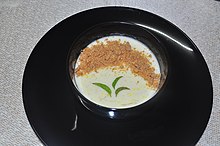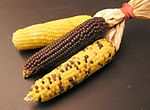Ginataang mais
  | |
| Alternative names | mais sa gata, lugaw na mais, lelut mais |
|---|---|
| Course | Dessert |
| Place of origin | Philippines |
| Serving temperature | Warm or cold |
| Main ingredients | sweet corn kernels, glutinous rice, coconut milk, sugar |
Ginataang mais is a Filipino sweet corn and rice gruel. It is also known as lugaw na mais (Kapampangan: lelut mais). It is a type of dessert lugaw and ginataan.[1] It is eaten warm in colder months, but can also be eaten cold during summer. Ginataang mais means "corn in coconut milk" in Filipino.
Ginataang mais is made by boiling glutinous rice (malagkit) until almost done. Sweet corn, coconut milk (gata), and sugar are then added and the heat lowered shortly before the rice is fully cooked. In some recipes, coconut milk is added after cooking.[2][3][4] Evaporated milk can also be used in place of coconut milk. Other ingredients may also be added, like latik (coconut caramel), pinipig (pounded young rice kernels), jackfruit, fresh grated coconut, butter, and vanilla.[5][6][7]
See also[]
- Binaki
- Binatog
- Ginataang munggo
- List of maize dishes
- Maíz con hielo
- Pozole
References[]
- ^ Jorolan, Poch. "Lelut Mais (Lugaw na Mais)". Yummy.ph. Retrieved 6 December 2018.
- ^ "Ginataang Mais (Corn in Coconut Milk)". SEASite. Center for Southeast Asian Studies, Northern Illinois University. Retrieved 6 December 2018.
- ^ Abigail, Caldoy. "Ginataang Mais (Corn and Sticky Rice Pudding with Coconut Milk)". Tasty Kitchen. Retrieved 6 December 2018.
- ^ "Ginataang Mais". Kawaling Pinoy. Retrieved 6 December 2018.
- ^ Santos-Agoncillio, Judy Ann. "The Happy Home Cook: Ginataang Mais". Judy Ann's Kitchen. Positively Filipino. Retrieved 6 December 2018.
- ^ "Corn with coconut milk (Ginataang mais)". The Ivory Hut. Retrieved 6 December 2018.
- ^ "Ginataang Mais (Sweet Corn with Coconut Milk) Recipe". Panlasang Pinoy. Retrieved 6 December 2018.
- Maize dishes
- Philippine desserts
- Foods containing coconut
- Rice dishes
- Philippine rice dishes
- Vegetarian dishes of the Philippines

